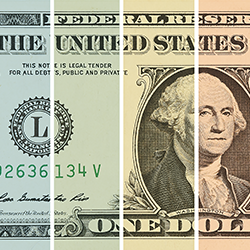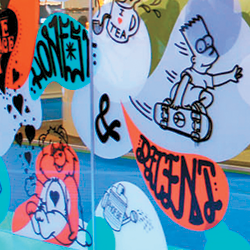|
REGISTRATION REQUIRED
graphics
 ILLUSTRATION: JOÃO NEVES Graphics are an often costly but critical component of an exhibit-marketing program. So EXHIBITOR spoke with multiple industry professionals to identify four vital factors that affect graphic-related fees – and to uncover myriad ways to curtail costs. By Linda Armstrong
Art and Production
One important set of factors that affects graphic costs is the manner in which you develop and deliver artwork, along with how you manage the production process. Here are five quick tips to ensure you don't spend more than you have to in these areas. ➤ Minimize manipulation time. "Every minute graphic designers, whether at your exhibit house or graphic-supply firm, spend preparing your artwork for production will impact costs," says Josh Terceira, senior graphic designer at Hill & Partners. "So it's in your best interest to ensure that what you submit to your supplier clearly aligns with what that firm needs in terms of file types, sizes, colors, etc." ➤ Develop an image inventory. Mike Friedland, vice president of client services at Access TCA Inc., suggests that you develop an internal inventory of all artwork, logos, and potential size limitations. "Often, various departments within a company already have large-format imagery on file," Friedland says. "But when it comes time to produce exhibit graphics, exhibit managers may not be aware of or able to locate these high-res images. With a bit of internal research, compilation, and organization, you're less likely to pay graphic suppliers to reinvent the wheel." ➤ Allow enough time. "Each project will have a slightly different timeline, but if you can allow four to six weeks from start to finish of your graphic-creation process, you should have the opportunity to tweak the design, review hard-copy proofs, and even test how the graphics fit into their frames long before you have to ship everything to the show," says Geoffrey Kilmer, president of Photoworks Creative Group. "After all, you don't want to be making expensive last-minute changes or corrections on the show floor. Plus, by allowing plenty of time throughout the process, you'll often catch typos, color errors, and more, and still have time to correct them." 
Long-Term Planning As the saying goes, "A failure to plan is a plan to fail." A lack of long-term vision and strategic planning may not cost you straight out of the gate, but it can increase your graphic expenses over time. ➤ Design for reuse and avoid customization. "One of the best ways to save on graphics is to reuse your elements, which could include everything from repurposing panels for multiple exhibit configurations to using fabric exhibit banners at user-group meetings or corporate events," says Dana Tilghman, CTSM, CMP, senior trade show and events planner at Minitab Inc. To extend the life of a graphic beyond a single event, graphics should be somewhat generic as opposed to customized with show dates or booth numbers. If you must customize a graphic for a specific show, Friedland suggests applying vinyl customization, which can later be removed to create nonshow-specific elements, or pairing your graphics with digital messaging that can be customized on the fly. 
"If your exhibit house is not your graphic provider, you're likely paying a markup on graphic design and production fees," says Chris LaRoy, senior manager of industry events and trade shows at Cox Automotive Inc. "If those markups are substantial, ask for a discount and analyze whether working directly with a graphic provider would be more cost effective. However, also consider the potential hassles and time expenditures of working with two vendors instead of one." ➤ Plan ahead. "The No. 1 way to save money is to plan ahead," Kilmer says. "Many exhibit managers don't have a firm grasp of the sizes, colors, and number of graphics they need over the course of a year. They often take more of a 'produce-on-demand' mentality. But if you do some long-term planning and know exactly what graphics you need and when, they can be produced more cost effectively." Kilmer also recommends that if you are purchasing one large batch of graphics instead of multiple one-off orders, you can submit RFPs to multiple service providers. "Doing so allows you an apples-to-apples price comparison, which can ultimately help you choose the most qualified, cost-effective provider."
Graphic Alternatives
➤ Maintain an accurate inventory. One surefire way to decrease the costs of traditional fabric or hard-panel graphics is to do away with them. "Digital messaging mediums can often reduce up-front costs, particularly if you want to offer information customized to each show or event," says Mike Friedland, vice president of client services at Access TCA Inc. "Plus, digital media in and of itself can add movement, interest, and prominence. However, digital comes with additional costs, including everything from rigging and electrical to content creation and monitor rental." Bottom line: Digital isn't the solution to every challenge, but a quick price comparison can help you determine if it's a cost-effective fit for your needs. To make the most of existing graphics and to ensure you're not constantly reinventing the wheel, inventory management is critical, according to Matt Hartline, creative director at Absolute Exhibits Inc. "Work with your exhibit house or independently to develop an inventory system that tracks each graphic, not to mention each piece of exhibitry, and records its location and intended uses." If you don't have a system to track your properties, you could easily end up reproducing graphics unnecessarily. ➤ Investigate costs of reuse versus reproduction. While it's usually cost effective to reuse graphics multiple times, don't forget to factor in the costs of getting it back to your storage facility after a trade show. "The downside to reuse of some mediums is shipping and storage," says Alan Sartain, director of graphic design and production at The Expo Group Inc. "If your graphics are large, heavy, oddly shaped, and perhaps infrequently used, it might be cheaper to recycle them after a show rather than to ship them back to a warehouse and store them. That's certainly not always the case, but it's wise to do the math to determine the best possible cost savings." Materials All graphic mediums are not created equal, as each offers various benefits and drawbacks, not to mention a range of price points. So material selection and usage are important cost drivers – and key areas in which to trim costs. ➤ Analyze material fees. "Always ask your graphic supplier to price out multiple material options," Friedland says. "Less-traditional substrates may offer benefits over standard options, but they come at a price. By simply understanding the mediums and their price tags, you can make cost-conscious – as opposed to blind – choices." Overall, materials that are considered standard, are readily available, and are already housed within the graphic-production facility will likely be less expensive than nontraditional versions. 
➤ Compare required graphic sizes to material standards. Many materials come in standard sizes, and if your graphic requirements exceed a specific material's size parameters, you'll either have to marry seams or purchase custom materials, both of which have drawbacks. "Seams can be unsightly and very difficult to match without the right tools, and doing so takes time and money," says Aeon Brady, graphics production manager at Professional Exhibits & Graphics. "Plus, the cost of using nonstandard sizes can double or triple your raw-material costs. And if you purchase a nonstandard size of material, your production firm may not have equipment capable of printing on it," Sartain says. ➤ Leverage purchases. "The more graphic elements an exhibitor can cut out of a piece of material, the fewer sheets that need to be purchased, and the less waste there is," Friedland says. "For example, if you have a standard 4-by-8-foot sheet of Plexiglas, you can get possibly four 24-by-48-inch panels out of one sheet. But to generate four 36-by-48-inch panels, you'll have to purchase two sheets. An additional sheet won't break the bank, but over time, those costs add up. So plan ahead to make the most of each panel you purchase." ➤ Explore remnants. "Ask your exhibit house if there are other exhibitors purchasing new graphics and if you can piggyback on that material order or even purchase their leftover materials to decrease costs," Tilghman says. Also ask your firm if it regularly employs remnants. "Our production department 'gangs' multiple client jobs together so materials are used in the most efficient manner across numerous clients," says Tom Trutna, president of Eagan, Minnesota-based Big Ink Display Graphics. Weight, Size, and Handling The weight and size of your graphics have a bearing on multiple cost factors, such as shipping, drayage, storage, and even installation and dismantle, given assembly and ease-of-handling attributes. However, these planning strategies and practices can help reduce fees in this area. 
➤ Investigate crate weight. "When purchasing graphics, always consider the weight of not only the graphic medium itself but also the crating or materials required to store and ship the graphics," Kilmer says. Graphics printed on rigid substrates may require heavy protective cases to prevent damage during shipment or storage. "In the end, it pays to do your homework," he says. "Sometimes, a more durable substrate, such as dye-sublimation fabric, may allow you to use less-protective and lighter weight shipping containers to safeguard your graphic investment, thereby saving you money in the long run." ➤ Scrutinize size-related charges. The sizes and dimensions of your graphics also affect costs, as odd or oversized parcels will cost more to transport than smaller, more standard-sized packages. "Anything that can be rolled or folded will likely save you considerable costs on shipping and storage," Friedland says. "And saving money is always a priority." E
|
|
|
||||||||||||||||||||||||||||
|
|
||||||||||||||||||||||||||||
|
TOPICS Measurement & Budgeting Planning & Execution Marketing & Promotion Events & Venues Personal & Career Exhibits & Experiences International Exhibiting Resources for Rookies Research & Resources |
MAGAZINE Subscribe Today! Renew Subscription Update Address Digital Downloads Newsletters Advertise |
FIND IT Exhibit Producers Products & Services All Companies Get Listed |
EXHIBITORLIVE Sessions Exhibit Hall Exhibit at the Show Registration |
ETRAK Sessions Certification F.A.Q. Registration |
EDUCATION WEEK Overview Sessions Hotel Registration |
CERTIFICATION The Program Steps to Certification Faculty and Staff Enroll in CTSM Submit Quiz Answers My CTSM |
AWARDS Exhibit Design Awards Portable/Modular Awards Corporate Event Awards Centers of Excellence |
NEWS Associations/Press Awards Company News International New Products People Shows & Events Venues & Destinations EXHIBITOR News |
||||||||||||||||||||
|
||||||||||||||||||||||||||||






